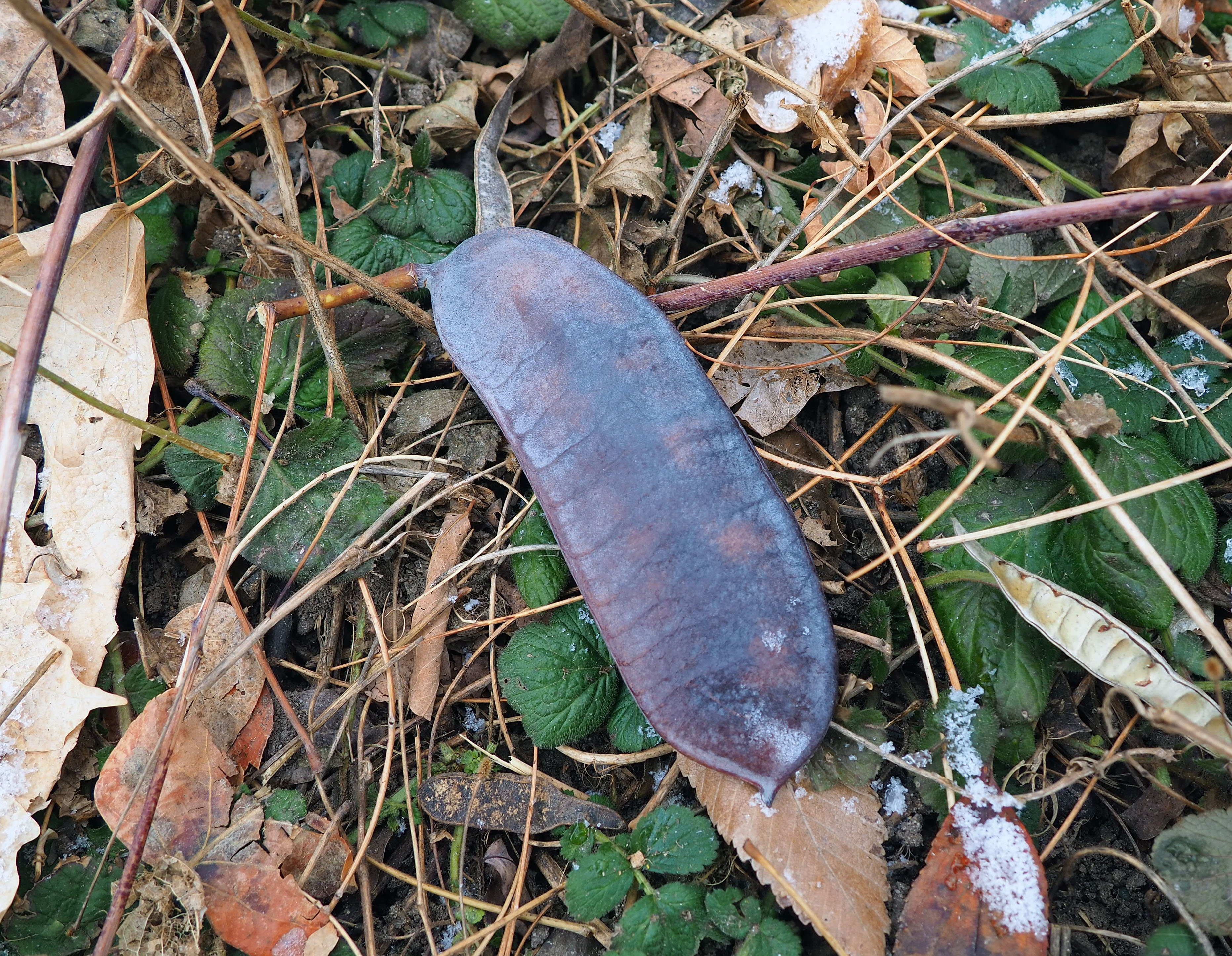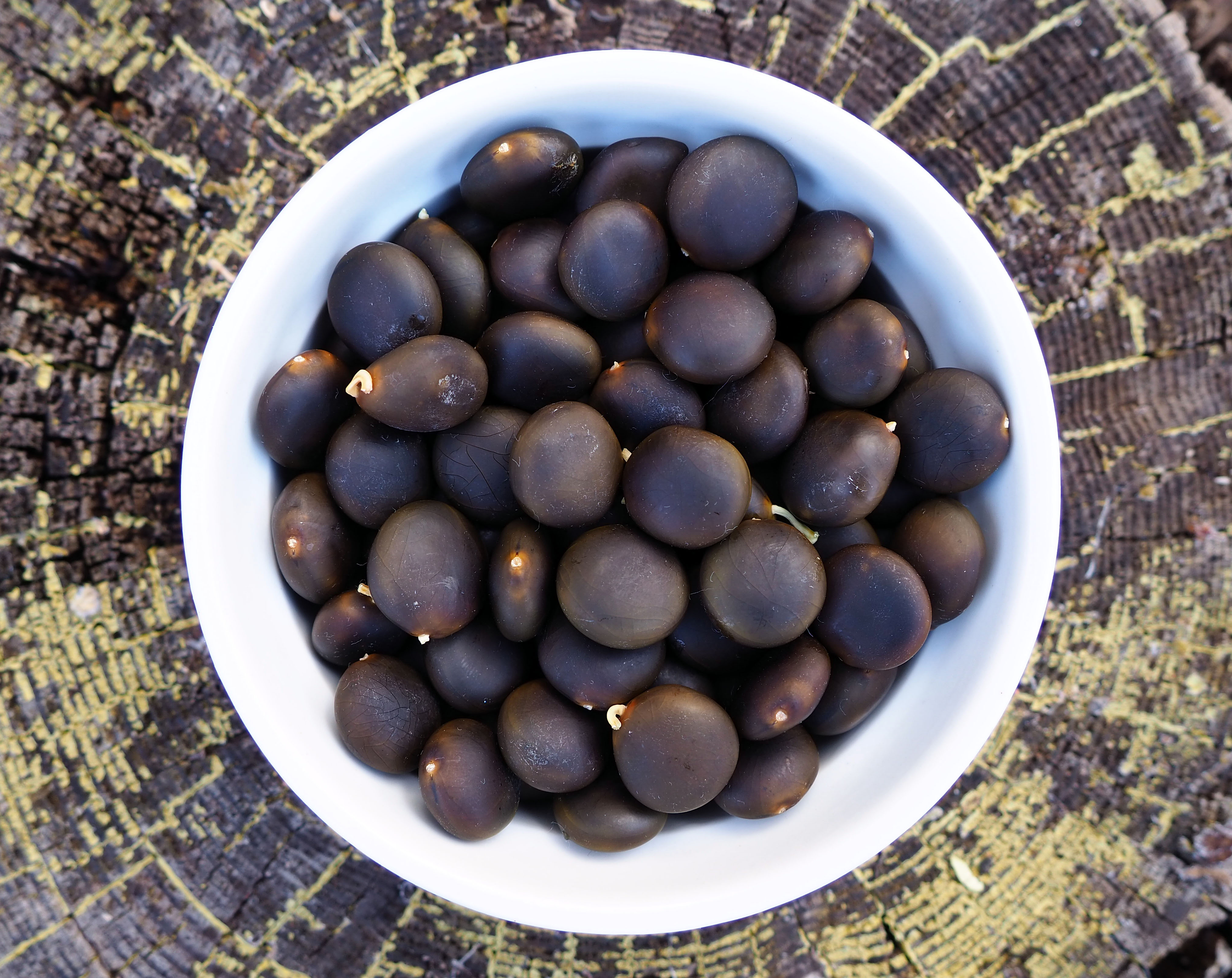Learning to identify Kentucky coffeetree in the winter brings you one step closer to making a coffee-like (albeit caffeine-free) beverage from its seeds. Humans have a long history of occasionally using the “beans” of Gymnocladus dioicus to make this tisane, which explains common names like coffeetree, American coffee berry, and coffeenut. The process is a bit time consuming, and the end result is mixed, but foraging adventures like this are all about the experience. This drink is not likely to replace whatever you are currently drinking in the morning, but it does offer an interesting diversion.

Winter is the best time to collect the pods, which are flat, leathery, brown to black in color, and about 2 inches wide and 6 inches long. The stocky fruits are often found hanging from the tips of the tree’s bare branches. Many also fall to the ground over the course of the season, making them easier to collect. If you split the pods open early in the season, you’ll find the seeds embedded in a sticky, neon green goo that will stick to your hands and clothes. As the year progresses, the glue-like substance dries out and is easier to deal with. The seeds are dark, extremely hard, rounded and flattened, and about the size of a penny or nickel. The funiculus, which is a short stalk that connects the ovule/seed to the ovary, tends to be fairly prominent and something you don’t often get to see on seeds.

Once you’ve collected several pods and removed the seeds from the gooey innards, soak the seeds for an hour or two and then rinse them, making sure to remove dried up goo and any remaining funiculi. Pat the seeds dry and place them in a baking dish with a lid for roasting. The roasting process is said to eliminate the toxicity of the seeds. The lid is important because several of the seeds will pop open during roasting and will fly around in your oven if they aren’t contained.
The fruits of Kentucky coffeetree contain a toxic compound called cytisine, an alkaloid that is similar in action to nicotine. The Handbook of Poisonous and Injurious Plants by Nelson, et al. states that “the cytisine content of the seeds is quite low; and chewing one or two would not be expected to produce toxic effects.” Actually, the bigger risk of chewing one of these rock hard seeds is breaking your teeth. Cytisine poisoning includes typical symptoms like diarrhea and vomiting; in extreme cases it can lead to coma and death. If the seeds are properly roasted, you won’t have to worry about any of this, but as with anything you are trying for the first time, start with small amounts.

Times and temperatures for roasting vary depending on who you’re getting your information from. I went with 300° F for 3 hours (which ended up being 3 and a half hours because I forgot to take them out in time). One source suggested roasting the seeds for only 2 hours for better flavor, but I decided to err on the side of caution and roast them for longer. Many of the seeds will have popped open during the roasting process. For those that haven’t you will need to use a nutcracker or some other comparable tool to crack the seed coat and remove the insides. Dispose of the seed coats and grind the remaining bits into a fine powder using either a coffee grinder or mortar and pestle. You’ll end up with a fine, chocolate-colored powder which you will use to make your “coffee.”
You can prepare this beverage in the same way you would typically choose to make coffee, but keep in mind that upon adding water, the fine grounds quickly turn to a mud-like substance and will block up the filter you are using. For this reason, I recommend small batches. I found Kentucky coffeetree “coffee” to be very earthy and rich and somewhat similar to strong black coffee. Sierra tried it and immediately exclaimed, “That’s nice!” and then proceeded to give it two thumbs up. Some people like black coffee. I added cream to it and found it much more pleasant to drink. Other people don’t think this beverage tastes like coffee at all and instead call it tea-like, chocolaty, fruity, or “akin to mud,” among other more negative reviews. I think it’s a drink that could grow on me, but considering the effort it takes to make one cup, I don’t see that happening any time soon.

Have you tried making “coffee” from the seeds of Kentucky coffeetree? Let us know what you think about it in the comment section below.
More Tea Time Posts on Awkward Botany:
